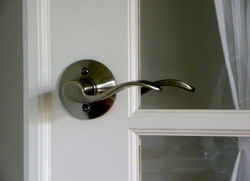 No matter the design, door knobs to go away.
No matter the design, door knobs to go away. ____________________________________________________________________________
It is a ubiquitous piece of equipment found in virtually every building, a requirement for entry, a necessity for exit.
For some, the humble round doorknob is unremarkable and utilitarian, a simple tool, a means to an end. For others, it is a piece of art, an object of beauty, an architecturally significant adornment on the welcoming portal to a building. For others, it is so synonymous with ordinariness that a “knob” is a pejorative word for being dull or stupid.
In Vancouver, the doorknob is heading into a setting sun. Its future has been date-marked, legislated out of existence in all future construction, a tip to society’s quest for universal design and the easier-to-use lever handle.
And as it goes in Vancouver, so will it go in B.C., Canada, and perhaps even the world.
Vancouver is the only city in Canada with its own building code, so the changes made here are often chased into the B.C. Building Code and Canada’s National Building Code, and then put into practice in cities and towns across Canada. Vancouver’s influence is wide. And as go the codes, so too goes the construction industry.
Remember the regular toilet? Try to find one. Low-flush is all there is to be had. The incandescent light bulb? Sorry, just energy-saving fluorescent or LED now in most stores.
The change has crept up on us silently and without fanfare. Look at any new condo building. Any new office door. Any door to a public washroom that doesn’t have pneumatic hinges and a push-pad. There they are, these silver, black or brass-coloured levers that can spring a door open with even a forearm when hands are filled.
And, as doorknobs go, so too will go those other ubiquitous knobs, the ones that turn on and off water faucets. For they too are being legislatively upgraded to levers more conducive to the arthritic, gnarled or weakened hands we earn with age.
In September, Vancouver council adopted new amendments to its building code, effective next March, that, among other things, will require lever handles on all doors and lever faucets in all new housing construction.
It is not like the doorknob will disappear entirely. Like many inventions, it will hold its own for a long, long time. There are, after all, a few people who still use typewriters instead of computers. Vancouver’s rule is not retroactive to existing homes. But over time, the effect will become magnified as housing is replaced.
Vancouver has already signalled how serious it was about this change. Last year, before the amendments were proposed, city maintenance workers quietly removed most of the Art Deco doorknobs from the public doors in the heritage-listed City Hall, which was built in 1936. Where once the public, politicians and bureaucrats alike grasped ornate brass knobs with a stylized face embossed with “VCH” — for Vancouver City Hall — they now find utilitarian gold-coloured levers.
Finnish architect Juhani Pallasmaa has described the door handle as “the handshake of a building.” If that is so, the doorknob has made a lot of introductions.
The origin of the doorknob is lost in history. Long before its emergence, people opened, closed and latched doors with wood handles, iron bars, leather thongs, strings, cables, rudimentary latches, anything at hand.
According to Allen Joslyn, the president of the Antique Door Knob Collectors of America, the first true knobs were likely simple pulls on church and palace doors.
“People always ask me what the first doorknob was. I tell them you tell me when the first door was made and I’ll be able to figure out when the first doorknob was made,” he said, in a telephone interview.
In the U.S., the first patent for pressing glass knobs by mechanical means was granted in 1824 to Pittsburgh’s John P. Bakewell for use as furniture pulls. Two years later, Henry Whitney and Enoch Robinson of the New England Glass Company in Cambridge, Mass., patented a variation of the glass pressing machine for making doorknobs.
If imitation is a sincere form of flattery, Whitney and Robinson didn’t take it well; in 1831, in what was the first patent infringement suit involving knobs in America, they sued another glass knob maker named Emmett and won $500. That same year another glass maker, Spencer Richards of Cambridge, Mass., patented one of the earliest versions of a single knob design.
Robinson broke away from New England Glass, and in the next half-century built an empire as a knob and lock manufacturer and obtained many patents. He had a passion for round things; in 1856, he built a striking round three-storey wood frame house in Sommerville, Mass. that still stands. From the air, it even resembles a knob.
Joslyn says the heyday of highly decorative and collectible knobs ran from the 1840s to about 1915, but adds that lots of decorative knobs were made in later years, such as the ones at Vancouver City Hall.
He doesn’t think Vancouver’s building code amendments will kill the doorknob-making industry. There is, after all, a vibrant industry in the manufacture of reproduction knobs for decorative purposes. But he wonders if Vancouver has gone too far.
“I can understand if you have a public building where everybody wants to have free access and that is a problem,” he said. “But to say that when I build my private home and nobody is disabled that I have to put levers on, strikes me as overreach.”

Tim Stainton, a professor and director of the School of Social Work at the University of B.C., says the concept is based around building a society as open as possible to everyone, rather than creating exceptions to fit a few.
“Basically, the idea is that you try to make environments that are as universally usable by any part of the population,” he said. “The old model was adaptation, or adapted design. You took a space and you adapted for use of the person with a disability. What universal design says is let’s turn it around and let’s just build everything so it is as usable by the largest segments of the population as possible.”
Stainton says there are examples of universal design all around us that we may not even recognize as such.
“A really simple version is the cut curbs on every corner. That helps elderly people, people with visual impairments, moms with strollers. It makes a sidewalk that could otherwise be difficult for parts of the population universally accessible,” he said.
A more oblique example is patterned china and thicker cutlery in some restaurants.
“If you are visually impaired, a white plate on a white tablecloth is difficult to see. You may not be able to distinguish where the plate ends and the table starts. In a lot of places you won’t see plain white china any more. They will design a ring around it, or change the edges,” Stainton says.
Fire alarms with flashing lights are another example. “A sonic fire alarm doesn’t do anything for a person who is deaf. So now, all the alarms you see will have a light on them,” he said. “You don’t want to be the only person sitting in a building on fire thinking ‘where did everybody go’.”
And the door lever? Until this story, you probably didn’t pay attention to what you use to open a door, Stainton suggests.
“Most people don’t think twice now about a doorknob in their office. They don’t think ‘Oh, I don’t have a doorknob but I have a lever.’ They don’t think of that lever as anything other than a way to open the door, and that is the logic here.”
Will Johnston, the former Vancouver chief building inspector who wrote the changes in consultation with the building industry, doesn’t see this as the inevitable death of the doorknob because the rules aren’t retroactive. People can also still buy doorknobs and put them back on lever handle-equipped houses.
But he won’t bemoan the loss of the knob.
“We keep talking about the doorknob. Go into Home Depot and look at how many lever door handles there are. There are lots because that is the trend,” he said, adding that with handles you don’t require a tight grasp.
“Technology changes. Things change. We live with that. … When I look at what we are proposing, it is simply good design. It allows for homes to be built that can be used more easily for everybody.”
vancouversun.com/jefflee

 RSS Feed
RSS Feed